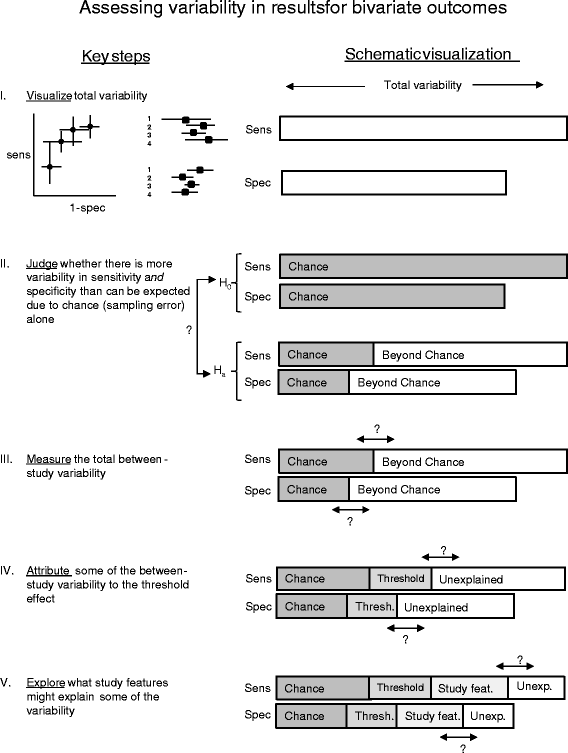Assessing variability in results in systematic reviews of diagnostic studies
- PMID: 26772804
- PMCID: PMC4714528
- DOI: 10.1186/s12874-016-0108-4
Assessing variability in results in systematic reviews of diagnostic studies
Abstract
Background: To describe approaches used in systematic reviews of diagnostic test accuracy studies for assessing variability in estimates of accuracy between studies and to provide guidance in this area.
Methods: Meta-analyses of diagnostic test accuracy studies published between May and September 2012 were systematically identified. Information on how the variability in results was investigated was extracted.
Results: Of the 53 meta-analyses included in the review, most (n=48; 91%) presented variability in diagnostic accuracy estimates visually either through forest plots or ROC plots and the majority (n=40; 75%) presented a test or statistical measure for the variability. Twenty-eight reviews (53%) tested for variability beyond chance using Cochran's Q test and 31 (58%) reviews quantified it with I(2). 7 reviews (13%) presented between-study variance estimates (τ(2)) from random effects models and 3 of these presented a prediction interval or ellipse to facilitate interpretation. Half of all the meta-analyses specified what was considered a significant amount of variability (n=24; 49%).
Conclusions: Approaches to assessing variability in estimates of accuracy varied widely between diagnostic test accuracy reviews and there is room for improvement. We provide initial guidance, complemented by an overview of the currently available approaches.
Figures
Similar articles
-
The Moses-Littenberg meta-analytical method generates systematic differences in test accuracy compared to hierarchical meta-analytical models.J Clin Epidemiol. 2016 Dec;80:77-87. doi: 10.1016/j.jclinepi.2016.07.011. Epub 2016 Jul 30. J Clin Epidemiol. 2016. PMID: 27485293 Free PMC article.
-
Meta-epidemiologic study showed frequent time trends in summary estimates from meta-analyses of diagnostic accuracy studies.J Clin Epidemiol. 2016 Sep;77:60-67. doi: 10.1016/j.jclinepi.2016.04.013. Epub 2016 May 20. J Clin Epidemiol. 2016. PMID: 27212137
-
Exploring sources of heterogeneity in systematic reviews of diagnostic tests.Stat Med. 2002 Jun 15;21(11):1525-37. doi: 10.1002/sim.1185. Stat Med. 2002. PMID: 12111918
-
Systematic reviews and meta-analyses of diagnostic test accuracy.Clin Microbiol Infect. 2014 Feb;20(2):105-13. doi: 10.1111/1469-0691.12474. Clin Microbiol Infect. 2014. PMID: 24274632 Review.
-
Systematic overview finds variation in approaches to investigating and reporting on sources of heterogeneity in systematic reviews of diagnostic studies.J Clin Epidemiol. 2014 Nov;67(11):1200-9. doi: 10.1016/j.jclinepi.2014.05.018. Epub 2014 Jul 22. J Clin Epidemiol. 2014. PMID: 25063558 Review.
Cited by
-
Diagnostic performances of common nucleic acid tests for SARS-CoV-2 in hospitals and clinics: a systematic review and meta-analysis.Lancet Microbe. 2021 Dec;2(12):e704-e714. doi: 10.1016/S2666-5247(21)00214-7. Epub 2021 Oct 13. Lancet Microbe. 2021. PMID: 34661181 Free PMC article.
-
Use of risk assessment instruments to predict violence in forensic psychiatric hospitals: a systematic review and meta-analysis.Eur Psychiatry. 2018 Aug;52:47-53. doi: 10.1016/j.eurpsy.2018.02.007. Epub 2018 Apr 4. Eur Psychiatry. 2018. PMID: 29626758 Free PMC article.
-
Preferred reporting items for journal and conference abstracts of systematic reviews and meta-analyses of diagnostic test accuracy studies (PRISMA-DTA for Abstracts): checklist, explanation, and elaboration.BMJ. 2021 Mar 15;372:n265. doi: 10.1136/bmj.n265. BMJ. 2021. PMID: 33722791 Free PMC article.
-
Comparison of the Diagnostic Accuracies of Procalcitonin and C-Reactive Protein for Spontaneous Bacterial Peritonitis in Patients with Cirrhosis: A Systematic Review and Meta-Analysis.Medicina (Kaunas). 2025 Jun 24;61(7):1134. doi: 10.3390/medicina61071134. Medicina (Kaunas). 2025. PMID: 40731765 Free PMC article.
-
From Serendipity to Precision: Integrating AI, Multi-Omics, and Human-Specific Models for Personalized Neuropsychiatric Care.Biomedicines. 2025 Jan 12;13(1):167. doi: 10.3390/biomedicines13010167. Biomedicines. 2025. PMID: 39857751 Free PMC article. Review.
References
-
- Dahabreh IJ, Chung M, Kitsios GD, Teruhiko T, Raman G, Tatsioni A, et al. Comprehensive Overview of Methods and Reporting of Meta-Analyses of Test Accuracy. Rockville: Agency for Healthcare Research and Quality (US); 2012. - PubMed
-
- Deeks J, Bossuyt P, Gatsonis C. Cochrane Handbook for Systematic Reviews of Diagnostic Test Accuracy Version 1.0 (Chapter 10). 2010.
-
- Borenstein M, Hedges LV, Higgins JP, Rothstein HR. Introduction to Meta-Analysis. Chichester: John Wiley & Sons; 2009.
-
- Cochrane Handbook for Systematic Reviews of Interventions. Chichester: Wiley-Blackwell; 2008.
Publication types
MeSH terms
LinkOut - more resources
Full Text Sources
Other Literature Sources
Medical


